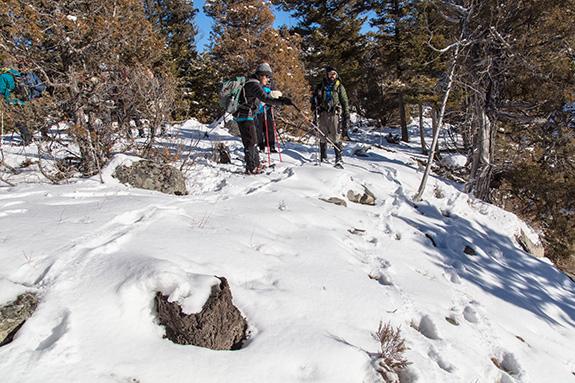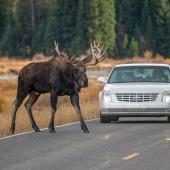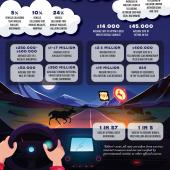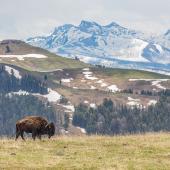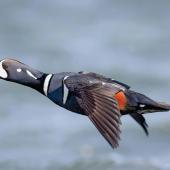The White Pages
Reading secrets in the snow.
The day began with a cougar track in the snow, followed by a mystery. The solution to that puzzle once again demonstrated how tracking during the winter reveals startling insights into the behavior of Montana’s wildlife.
The conditions weren’t the best for the mission, as warm winds had turned the snow to slush on the south-facing slopes. “Snow tracks” left by clots of melting snow dropping from the pines overhead dotted the white carpet underfoot. The track belonged to a small cat—most likely a young male—that no one intended to shoot. But the hounds needed the exercise and so did we, and a day in the mountains sounded more attractive than returning to my computer and a pile of deadlines.
As often happens in evaporating scent conditions, the hounds—we were training youngsters that day—promptly lost the track and went yapping away in the wrong direction. We decided to stay on the cat track and let the dogs find their own way back to the truck. There wasn’t anything particularly difficult about that, although we did have to do some casting about in several places where the track crossed barren rock that had already warmed enough to lose its snow cover.
We had covered a mile or two when I noticed something interesting in the snow up ahead: a long drag mark running down the hill along the fall-line. My first thought was that the cat had killed a deer and skidded the carcass down into the trees to hide it from scavengers. I’d run across plenty of lion kills over the years, but there was no blood or hair along the disturbance in the snow, which held intermittent jumping cat tracks. We followed the sign down the hill and found what I can only describe as a giant snowball. After climbing back to the beginning of the “drag” mark, we saw where the lion had used its paws to dig up snow and pack it together.
Continuing across the sidehill we found two areas similar to the first, with a snowball at the end of each. The cat had evidently spent the morning building snowballs and chasing them down the hill. Was he practicing his attack technique, working out, or simply having fun? We’ll never know. We never saw the lion either, but we didn’t have to. The snow had left a clear record of a mountain lion engaging in an activity that would have been virtually impossible to observe in real time. That’s why I’ve always loved to spend my Montana winters on foot in the hills, reading the white pages.
Much of my own tracking knowledge derives from hunting experiences, but don’t let that bother you if you’re not a hunter. To repeat a cliché, no wildlife was harmed in the making of the anecdotes that follow. In fact, that’s one of the joys of tracking, which can become hunting’s counterpart to catch-and-release fishing.
Over the years I’ve followed all kinds of wildlife tracks across all kinds of terrain, from the Arctic to the tropics. I’ve even enjoyed the privilege of tracking with the world’s best, the Indigenous San hunters of the Kalahari Desert, who take the process beyond an art form and into the realm of the spiritual. But there’s no better time or place to use tracking as a window upon the world of wildlife than right here in Montana during the winter, especially with fresh snow on the ground. Furthermore, winter tracking provides a wonderful excuse to enjoy one of my favorite aspects of life in Montana: backcountry solitude.
And what stories the snow has to tell! One day I cut a cougar track on a ridgetop. Wind had blown powder into the tracks and it was hard to tell much about the cat, so I decided to walk the track out under the canopy and try to learn more about lion. In the shelter beneath the trees, the single track soon became a multitude of cat prints, which often indicates a kill nearby. I soon came upon a fresh, partially eaten mule-deer carcass, now surrounded by the tracks of a female lion with several half-grown kittens.
Then I noticed a second mound of fur 20 yards away in a copse of Christmas trees and carefully walked over to investigate. (Every time you put your own foot down in the snow, you risk destroying evidence.) The fur turned out to be the remains of a dead coyote, and once again the snow told the story. Attracted by the scent of the dead deer, the coyote had come creeping in through the brush looking for an easy meal, but the adult lion had caught it in the act. Mom had then plopped down in the snow and stood guard as her kittens devoured the hapless coyote. Shakespearean drama or just another day in the life and death of Montana wildlife? I don’t know how best to answer that question, but I never would have had the chance to ask it if I hadn’t followed the track.
Opportunities to track winter wildlife abound in our area, on public land, with no licenses or special equipment required except a daypack with winter survival gear and perhaps a pair of snowshoes. While tracking skills are best developed through experience, useful resources are available including the excellent Field Guide to Tracking Animals in Snow (Stackpole Books), by Bozeman author Louise Forrest (now Louise Davis).
You don’t need to be hunting anything to enjoy the winter tracking experience. The “trophy” (a term I detest) may be nothing more than an unexpected track left by a wolverine or a Canadian lynx, or a chance to unravel one of the many mysteries of the woods. Even if you find nothing that exciting, you will be outdoors becoming a better naturalist.



